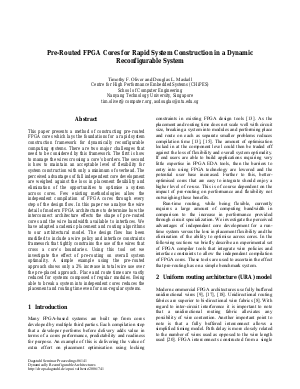Pre-Routed FPGA Cores for Rapid System Construction in a Dynamic Reconfigurable System
Authors Douglas Maskell, Timothy F. Oliver
-
Part of:
Volume:
Dagstuhl Seminar Proceedings, Volume 6141
Part of: Series: Dagstuhl Seminar Proceedings (DagSemProc) - License:
 Creative Commons Attribution 4.0 International license
Creative Commons Attribution 4.0 International license
- Publication Date: 2006-10-09
File

PDF
DagSemProc.06141.12.pdf
- Filesize: 457 kB
- 10 pages
Document Identifiers
Subject Classification
Keywords
- Dynamic Reconfiguration
- Rapid Construction
- FPGA Routing matrix
Metrics
- Access Statistics
-
Total Accesses (updated on a weekly basis)
0Document
0Metadata
Abstract
This paper presents a method of constructing pre-routed FPGA cores. This lays the foundations for a rapid system construction framework. There are two major challenges that need to be considered by this framework. The first is how to manage the wires crossing a core’s borders. The second is how to maintain an acceptable level of flexibility for system construction with only a minimum of overhead. Typical FPGA based systems are built up from cores developed by multiple third parties. Each compilation step that a developer performs before delivery adds value in terms of a cores performance, predictability and readiness for purpose. The perceived advantages of full independent core development are weighed against the loss in placement flexibility and elimination of the opportunities to optimise a system across cores. Few existing methodologies allow the independent compilation of FPGA cores through every step of the design flow. The wire detail of modern FPGA architectures is captured in a model that is used to analyse how the interconnect architecture effects the shape of pre-routed cores and the wire bandwidth available to interfaces. We have adapted academic placement and routing algorithms to our architectural model. The design flow has been modified to include a wire policy and interface constraints framework that tightly constrains the use of the wires that cross a core’s boundaries. Using this tool set we investigate the effect of pre-routing on overall system optimality. Compiling a set of example systems using the pre-routed approach shows only a 2% increase in total wire use over the pre-placed approach. Place and route times are vastly reduced for systems composed of regular modules. Being able to break a system into independent cores reduces the placement and routing time even for non-regular systems, and will open opportunities for its possible use in resource constrained embedded systems.
Cite As Get BibTex
Douglas Maskell and Timothy F. Oliver. Pre-Routed FPGA Cores for Rapid System Construction in a Dynamic Reconfigurable System. In Dynamically Reconfigurable Architectures. Dagstuhl Seminar Proceedings, Volume 6141, pp. 1-10, Schloss Dagstuhl – Leibniz-Zentrum für Informatik (2006)
https://doi.org/10.4230/DagSemProc.06141.12
BibTex
@InProceedings{maskell_et_al:DagSemProc.06141.12,
author = {Maskell, Douglas and Oliver, Timothy F.},
title = {{Pre-Routed FPGA Cores for Rapid System Construction in a Dynamic Reconfigurable System}},
booktitle = {Dynamically Reconfigurable Architectures},
pages = {1--10},
series = {Dagstuhl Seminar Proceedings (DagSemProc)},
ISSN = {1862-4405},
year = {2006},
volume = {6141},
editor = {Peter M. Athanas and J\"{u}rgen Becker and Gordon Brebner and J\"{u}rgen Teich},
publisher = {Schloss Dagstuhl -- Leibniz-Zentrum f{\"u}r Informatik},
address = {Dagstuhl, Germany},
URL = {https://drops.dagstuhl.de/entities/document/10.4230/DagSemProc.06141.12},
URN = {urn:nbn:de:0030-drops-7410},
doi = {10.4230/DagSemProc.06141.12},
annote = {Keywords: Dynamic Reconfiguration, Rapid Construction, FPGA Routing matrix}
}
